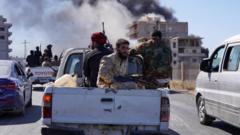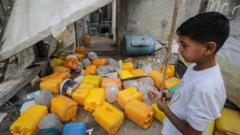The ongoing conflict between India and Pakistan has reached a level of intensity not seen since the 1971 war. The use of modern technology and disinformation has complicated the situation, creating a challenging environment for reporting and understanding the unfolding events.
# The Evolving Landscape of India-Pakistan Tensions: A Journalist's Perspective

# The Evolving Landscape of India-Pakistan Tensions: A Journalist's Perspective
As tensions between India and Pakistan escalate, a seasoned journalist reflects on the current state of conflict compared to historical skirmishes.
Empty line
As the conflict between India and Pakistan intensifies, the repercussions of this strain are felt beyond their borders, especially in the historically contested region of Kashmir. A veteran journalist shares that this rivalry has reached an alarming level reminiscent of 1971, the year marking the last major declared war between the two nations.
Reflecting on his childhood memories, he recalls the heightened tensions of that time—air raid sirens, blackouts, and emergency drills that descended upon communities. These feelings of anxiety have resurfaced during recent escalations, with both nations engaging in aggressive strategies and rapid strikes against one another.
The current conflict showcases a stark evolution in warfare tactics, heavily influenced by advanced technology. Unlike the 1970s, when news about the skirmishes was disseminated primarily through radio broadcasts, today's landscape is inundated with disinformation circulating across social media platforms and mainstream media outlets. This barrage of conflicting narratives has not only muddled public understanding but also amplified fears throughout the region.
The fervor of nationalism remains potent, yet its manifestation has transformed. India has transitioned from a largely agrarian society in the 1970s, where communities banded together to support military efforts with fundraising and supplies, to the world’s fifth-largest economy boasting considerable technological prowess. Such advancements, while signifying growth, have simultaneously fueled tensions, elevating the risks of collateral damage through the use of drones and sophisticated weaponry that can reaching beyond established boundaries.
Journalist Hari Kumar, who has dedicated over two decades to reporting from New Delhi, emphasizes that this present era demands a critical examination of not just the tactical operations at play but also the narratives shaping public perception amidst a rapidly changing and volatile environment.
As the conflict between India and Pakistan intensifies, the repercussions of this strain are felt beyond their borders, especially in the historically contested region of Kashmir. A veteran journalist shares that this rivalry has reached an alarming level reminiscent of 1971, the year marking the last major declared war between the two nations.
Reflecting on his childhood memories, he recalls the heightened tensions of that time—air raid sirens, blackouts, and emergency drills that descended upon communities. These feelings of anxiety have resurfaced during recent escalations, with both nations engaging in aggressive strategies and rapid strikes against one another.
The current conflict showcases a stark evolution in warfare tactics, heavily influenced by advanced technology. Unlike the 1970s, when news about the skirmishes was disseminated primarily through radio broadcasts, today's landscape is inundated with disinformation circulating across social media platforms and mainstream media outlets. This barrage of conflicting narratives has not only muddled public understanding but also amplified fears throughout the region.
The fervor of nationalism remains potent, yet its manifestation has transformed. India has transitioned from a largely agrarian society in the 1970s, where communities banded together to support military efforts with fundraising and supplies, to the world’s fifth-largest economy boasting considerable technological prowess. Such advancements, while signifying growth, have simultaneously fueled tensions, elevating the risks of collateral damage through the use of drones and sophisticated weaponry that can reaching beyond established boundaries.
Journalist Hari Kumar, who has dedicated over two decades to reporting from New Delhi, emphasizes that this present era demands a critical examination of not just the tactical operations at play but also the narratives shaping public perception amidst a rapidly changing and volatile environment.


















